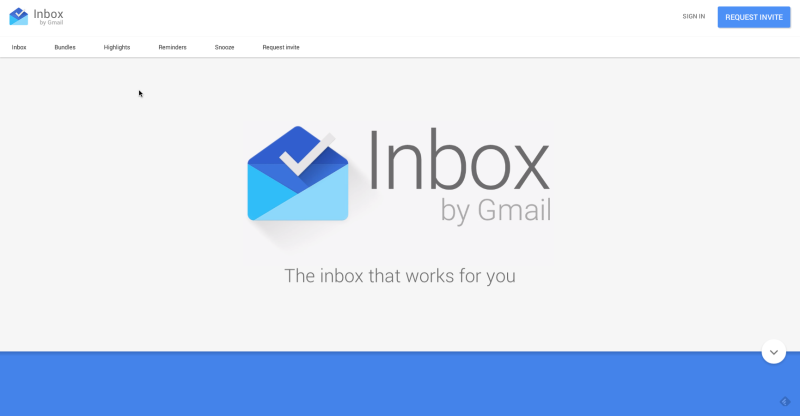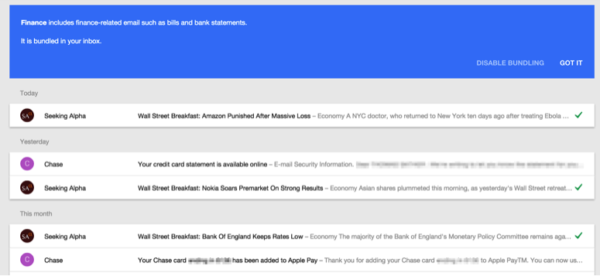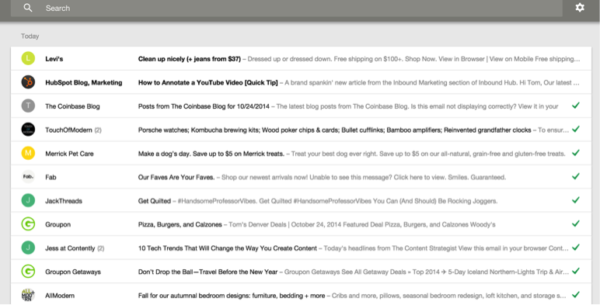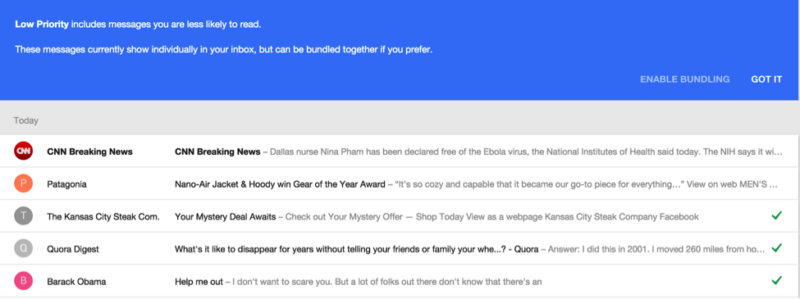How Email Marketers Can Prepare For Inbox By Google
That mobile email app that Google released (in beta, by invitation only) has a desktop counterpart. Contributor Tom Sather shares tips on how marketers can prepare for its adoption.
In late 2014, Google announced “Inbox by Google,” update to the nearly ten-year-old Gmail interface that is essentially a re-imagined email client for Gmail, but focused on helping people manage their busy lives. The effort takes the best ideas from products like Google Now and Gmail as well as from upstart email apps like Mailbox.
The invite-only revamped inbox also aims to make an inbox experience that is more relevant in today’s mobile world, as its interactivity relies strongly on touch-screen-like movements like swipes.
In a Reddit Ask Me Anything, Inbox’s developers shared some hints as to what drove the development of the new interface and said they hope it eventually surpasses the current standard Gmail interface:
[blockquote]The way people use email has changed a huge amount since we launched Gmail. With Inbox, we took a step back and did a lot of research into how most people are using email today. What we found was that email works as a to-do list for many people, that phone usage is starting to eclipse desktop usage, and that many people have negative feelings towards email because it feels like so much work. We built Inbox as a separate product because we didn’t feel like we could solve those problems by just adding more features on to Gmail. We needed to start from scratch to build a tool that really helps you stay on top of your life.[/blockquote]
Read on to explore the Inbox by Google features, and what marketers should start thinking about now if adoption grows.
The “New” Inbox – An Overview
Inbox by Google is the first Google interface designed using Google’s new design guidelines, Material Design. In fact, both Inbox by Google and Material Design were apparently developed side by side at the same time, according to the Google developer who mentioned on the Reddit AMA that some design guidelines created for Inbox first were later incorporated into the Material Design guidelines.
One of the guidelines for Material Design is to make information easily accessible, and “help users be fast and efficient.” Google accomplished this with Inbox through the use of Bundles, grouping emails by date ranges, quickly archiving messages and allowing a user to “snooze” an email or set a reminder based on geolocation.
Media, Documents More Prominent
YouTube videos are more visible as playable videos, and documents like PDFs also stand out in the new Inbox, both on webmail and in the mobile app. Gmail Classic only showed this while in the message.
Marketers could do some interesting things with video, with the added bonus that these emails will stand out in the inbox and grab subscribers’ attention as a result. No doubt this is also a play from Google to entice more businesses to use YouTube in their marketing efforts.
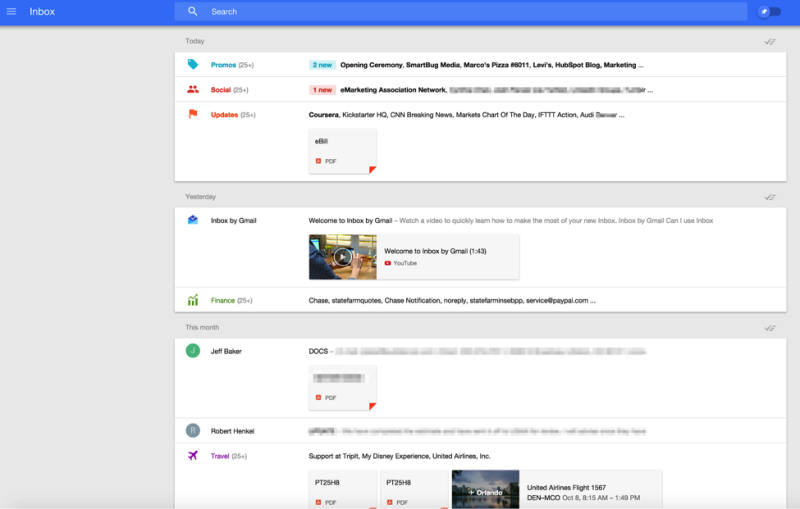
View of Inbox by Google shows PDFs and YouTube videos are more prominent
Bundle Up
Inbox by Google still includes the categories and tabs that appear in Gmail, but they’re now called Bundles. There are default bundles that are the same as the tabs in Gmail Classic (Social, Updates, Forums, Promotions), but Google added two new ones: Travel and Purchases.
Google also (finally!) added the ability to create custom categories. Custom Bundles are easy to create. You set the criteria or key word that you want emails to match on to be included in this bundle, and then choose when these messages should be bundled — real time, once a day at 7am, or once a week on Monday at 7am.
Purchases
This bundle type groups purchases based on date and displays an image of the purchase when available, as well as shipping details. As more retailers start to use electronic receipts like their online counterparts, locating past purchases is extremely easy, and users no longer need to sift through emails to see when a package will be delivered — since Inbox will prominently display recent tracking information.
Finance
The finance bundle groups finance-related emails together. This includes bills, electronic statements and financial-related newsletters.
Social & Updates
The social and updates bundles aren’t much different than the existing social and updates tabs in Gmail classic. The social category bundles social related emails and sorts by date, while updates are less-promotional communications from known companies.
Promos
Much like the Promotions tab in Gmail, and this bundles all marketing promotions into the “Promos” bundle.
A Feature Taken From Priority Inbox — “Low Priority”
Low Priority view shows messages that a person is less likely to read. This is most likely based on past engagement with certain brands, and appears to be only for Promos. These messages still appear in the inbox or in applicable bundles so there’s no fear that promotional emails will be lost in a sea of “low priority” messages.
Done!
Messages marked as “done” appear in the “done” view, which has replaced Gmail Classic’s “Archived” function. This is probably something more people will enjoy. Archived messages in Gmail are only viewable by searching. Marking a bundle of emails — in the case below a bundle of 25 purchases — shows a pop-up strikingly similar to Microsoft’s Sweep feature (well, at the least the name is the same).
How Marketers Can Take Advantage Of Inbox By Google
Will Inbox by Google replace Gmail? In the same Reddit chat mentioned above, Google developers said that in the short term, Inbox wouldn’t replace Gmail, but they weren’t shy about mentioning that replacing Gmail was a longer term goal. As a result, marketers should pay attention to future Inbox by Google developments, and start to prepare now. Here’s how.
1. Display Your Logo As The From: Address
One of the great things about the new Inbox by Google is that it is more visual. The sender of an email is displayed by an icon rather than a plain text From: address. This is similar to Gmail’s Grid View and works by:
- Having a verified Google+ business account
- Authenticating with SPF and DKIM
- Registering with Google
As a business or marketer, this is something you can do now to prepare for a possible widespread release of Inbox by Google. Additionally, by doing this now, your business icon will also appear in Gmail Classic’s Grid View for those that have it enabled.
2. Optimize For Snooze
The snooze feature is new to Gmail, and a user can snooze an email and choose to be reminded in two ways:
- Based on a user selected date and time
- Based on geolocation and pops up a reminder via geofencing
Marketers could have fun and test this feature by providing Gmail users instructions on how to snooze a message based on geolocation. How? Currently, users must enter in a location.
By providing users with the retailer’s nearest brick-and-mortar location in the email, a marketer could instruct the users to snooze the message until they are near the nearest store. It’s also extremely likely that Google will at some point do this automatically, taking cues from addresses or maps already embedded in emails.
3. Monitor Inbox Placement & Categorization
The spam folder in Inbox by Google is markedly absent, or at least out of easy view. One can only access the spam folder by clicking on the icon in the upper right hand corner to show the spam folder as well as the other bundles, folders and to-do lists.
Once in the spam folder, the “Not Spam” is also missing. However, users may access it by taking an extra step — selecting it from a drop down menu. More importantly, it appears that when marking an email as spam, it no longer gives you the option to also unsubscribe. Nor does Inbox by Google just automatically unsubscribe you when a list-unsubscribe header was present.
As a result of a hard-to-find spam folder, it’s likely users will miss emails delivered to the spam folder now more than ever before. As a result, marketers will see markedly lower open rates if their emails are being delivered to spam.
The lack of complaint management in the new Inbox by Google is likely a result of it being new and in beta. I suspect that Google will correct this in future releases. Until then, marketers should keep an eye on both adoption rates of Inbox by Google and their deliverability at Gmail. The same applies to categories. Since users treat each bundle or tab as a unique experience, marketers will need to ensure that their emails are being categorized correctly.
Opinions expressed in this article are those of the guest author and not necessarily MarTech. Staff authors are listed here.
Related stories
